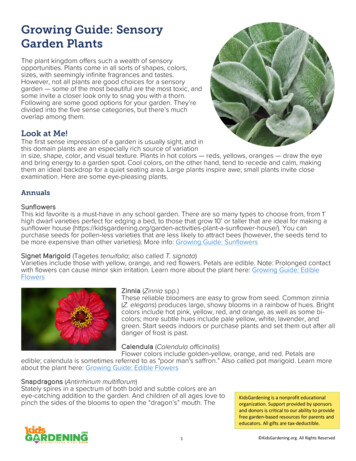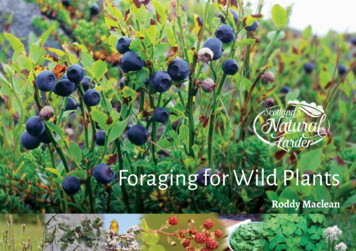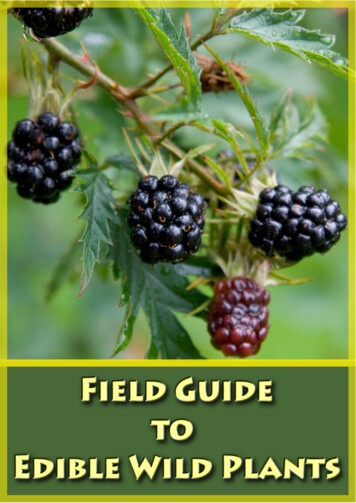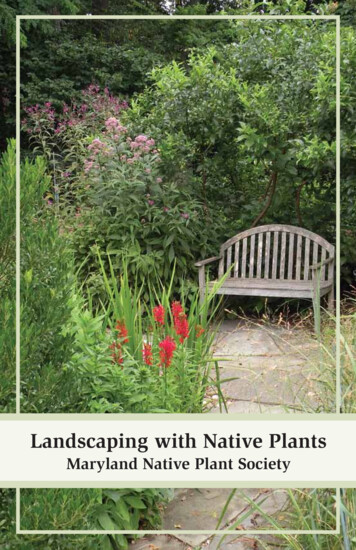
Transcription
Growing Guide: SensoryGarden PlantsThe plant kingdom offers such a wealth of sensoryopportunities. Plants come in all sorts of shapes, colors,sizes, with seemingly infinite fragrances and tastes.However, not all plants are good choices for a sensorygarden — some of the most beautiful are the most toxic, andsome invite a closer look only to snag you with a thorn.Following are some good options for your garden. They’redivided into the five sense categories, but there’s muchoverlap among them.Look at Me!The first sense impression of a garden is usually sight, and inthis domain plants are an especially rich source of variationin size, shape, color, and visual texture. Plants in hot colors — reds, yellows, oranges — draw the eyeand bring energy to a garden spot. Cool colors, on the other hand, tend to recede and calm, makingthem an ideal backdrop for a quiet seating area. Large plants inspire awe; small plants invite closeexamination. Here are some eye-pleasing plants.AnnualsSunflowersThis kid favorite is a must-have in any school garden. There are so many types to choose from, from 1’high dwarf varieties perfect for edging a bed, to those that grow 10’ or taller that are ideal for making asunflower house -a-sunflower-house/). You canpurchase seeds for pollen-less varieties that are less likely to attract bees (however, the seeds tend tobe more expensive than other varieties). More info: Growing Guide: SunflowersSignet Marigold (Tagetes tenuifolia; also called T. signata)Varieties include those with yellow, orange, and red flowers. Petals are edible. Note: Prolonged contactwith flowers can cause minor skin irritation. Learn more about the plant here: Growing Guide: EdibleFlowersZinnia (Zinnia spp.)These reliable bloomers are easy to grow from seed. Common zinnia(Z. elegans) produces large, showy blooms in a rainbow of hues. Brightcolors include hot pink, yellow, red, and orange, as well as some bicolors; more subtle hues include pale yellow, white, lavender, andgreen. Start seeds indoors or purchase plants and set them out after alldanger of frost is past.Calendula (Calendula officinalis)Flower colors include golden-yellow, orange, and red. Petals areedible; calendula is sometimes referred to as "poor man's saffron.” Also called pot marigold. Learn moreabout the plant here: Growing Guide: Edible FlowersSnapdragons (Antirrhinum multiflorum)Stately spires in a spectrum of both bold and subtle colors are aneye-catching addition to the garden. And children of all ages love topinch the sides of the blooms to open the “dragon’s” mouth. The1KidsGardening is a nonprofit educationalorganization. Support provided by sponsorsand donors is critical to our ability to providefree garden- ‐based resources for parents andeducators. All gifts are tax- ‐deductible. KidsGardening.org. All Rights Reserved
seeds are very small and need to be started indoors 10-12 weeks before planting outdoors, so it’seasiest to purchase transplants.Canna Lily (Canna generalis)These bold beauties grow from rhizomes that can be left in the ground in USDA Zones 7-10. In colderzones they need to be dug up and stored in a protected place each winter. The plants form impressivelylarge leaves and tall flower spikes. Some varieties’ leaves have interesting variegation.Bright Lights Swiss Chard (or similar variety)Multicolor stems in vibrant pink, yellow, magenta, red, and orange carry aloft the large green leaves.Learn more about the plant here: Growing Guide: Swiss ChardPerennialsPink Muhlygrass (Muhlenbergia capillaries)This well-behaved native grass forms an attractive clump that stays put — it doesn’t spread aggressivelylike some grasses. A perennial, it’s hardy in zones 5-10 and grows about 3’ tall and wide. In spring andsummer, the dark green, strappy leaves form an attractive mound. Come late summer, the real showbegins as masses of billowing pink flower plumes float and sway above the foliage, continuing into fall.The flower stems are nice additions to late summer bouquets and dried arrangements.Touch me!These are “hands-on” plants — offering a surprising variety of textures and surfaces, some begging tobe caressed, others offering a more “pointed” experience. In addition to plants, you can display roughpieces of bark, river-smoothed stones, pinecones, moss-covered branches, and other natural materialsto expand this touch-sense opportunity.AnnualsChenille Plant (Acalypha hispida)The flowers of this delightful plant droop in fuzzy pendants up to 18” long that just beg to be touched.The plant grows quite large — 4-6’ tall and wide, so give it plenty of space in a place where visitors canreach to caress the distinctive blooms. It’s hardy only to zones 10-11, so it’s usually grown as an annual.Celosia (Celosia spp.)There are numerous types of this common garden annual, all with showyblooms in an astonishing range of shapes and colors. Feather celosiasproduce fluffy, upright plumes. Wheat celosias have more compact, spikyflowers. Cockscomb celosias have velvety blooms that resemble brains!You can start seeds indoors about 8 weeks before your last spring frost,or purchase transplants.Strawflower (Xerochrysum bracteatum)This easy-to-grow plant has fascinating flowers. They resemble daisies, with a central yellow disksurrounded by petals. But these petals are actually bracts, and they’re glossy, stiff, and papery — anunexpected texture compared to the usual soft, velvety daisy petals. The flowers are also calledeverlastings, alluding to their use in long-lasting dried flower arrangements. Start the seeds indoors 6-8weeks before your average last frost date or use purchased transplants. Set these tender plants outafter the last frost date.Bunny Tail Ornamental Grass (Lagurus ovatus)A compact grass that grows just 12-18” high, this plant is covered withirresistibly fluffy seed-heads held high above the strappy leaves.2KidsGardening is a nonprofit educationalorganization. Support provided by sponsorsand donors is critical to our ability to providefree garden- ‐based resources for parents andeducators. All gifts are tax- ‐deductible. KidsGardening.org. All Rights Reserved
Caress the seed-heads in the garden, and cut some for dried arrangements. Sow seeds indoors about 8weeks before your last frost date, keeping the pots in a cool (55 degree) location. The seeds are slow togerminate — taking up to three weeks! — so be patient. If you can find transplants of this charming grass,that’s the easiest route. Wait until after your last frost date to plant outdoors.PerennialsLamb’s Ear (Stachys byzantina)Thick, velvety leaves are soft as can be and irresistible to touch and caress. The gray-green leaves arecovered with fine fuzz (especially the new growth) that makes them appear white when viewed fromsome angles, giving them visual appeal as well. This no-fuss perennial is hardy in zones 4-8. It toleratespoor soils; in rich soils it can spread somewhat aggressively.Hens and Chicks (Sempervivum tectorum)Several different plants go by the common name hens and chicks. Here we’re talking about theperennial plant that’s hardy in zones 3-8 and goes by another common name, houseleek. With perfectlysymmetrical rosettes of fleshy leaves with pointy tips and a fun name, these plants invite gazing andtouching. The “mother” hen forms offshoots (her chicks), so that in time they form a low, dense, 4” highmat. In summer the plants send up flower stalks.Smell Me!Our minds are so tuned into smells that one whiff of a fragrance can call up memories from events longago. Including plants with a variety of scents in your sensory garden offers visitors the opportunity toexplore the incredible variety of fragrances plants offer — and perhaps they’ll begin creating their ownolfactory memories!Annuals/Tender PerennialsBasil (Ocimum basilicum)Ubiquitous in a wide range of cuisines, basil is an easy-to-grow annual that thrives in the heat of summer.Leaves may be green or purple, frilly or smooth, large or tiny. Fragrance varies, too, with undertones thatinclude licorice, lemon, lime, clove, and more, depending on the variety. Just brushing by the plantreleases the scent; plucking a leaf and rubbing it really releases the fragrant oils. Start seeds indoors 6weeks before your last frost date or purchase transplants. Basil won’t tolerate chilly temperatures; setplants out a week after your last frost date and cover plant if temperatures drop into the high 50s. Moreinfo: Growing Guide: BasilPineapple Sage (Salvia elegans)This fragrant plant is a perennial in zones 8-10; in colder zones it’s easily grown as an annual. A shrubbyplant that grows up to 3’ tall with brilliant scarlet flowers, it’s a dramatic addition to the garden. Butthere’s more to it than meets the eye: Pluck a leaf and crush it, and savor the luscious pineapple scent.Pineapple sage is easiest to grow from purchased plants. Grow it in a pot and it can be overwinteredindoors.Curry Plant (Helichrysum italicum)The gray-green foliage somewhat resembles that of the lavender plant, but that’s where theresemblance ends. Instead of the sweetly herbaceous scent of crushed lavender leaves, the foliage ofcurry plant, when crushed, gives off a strong and distinctive scent of curry spices (though the plant isn’tactually used to make curry). It’s hardy in zones 7-10; elsewhere it’s grown as an annual. It grows 2-3’ talland wide and requires excellent drainage.Chocolate Cosmos (Cosmos atrosanguineus)KidsGardening is a nonprofit educationalorganization. Support provided by sponsorsand donors is critical to our ability to providefree garden- ‐based resources for parents andeducators. All gifts are tax- ‐deductible.3 KidsGardening.org. All Rights Reserved
Unlike its annual cousins with pink and white flowers, chocolate cosmos is a tender perennial hardy inzones 7-9. In colder regions, it can be grown as an annual or the tubers can be lifted and stored indoorsover the winter. The plant grows about 2’ high, and produces abundant brown-red flowers with a fun andunexpected chocolate scent. Cut some stems for an indoor bouquet with a delightful chocolately aroma!Scented Geraniums (Pelargonium spp.)Not to be confused with the showy red-, pink-, and white-flowered geraniums found in window boxesand planters nationwide, scented geraniums offer their gifts in a far more subtle fashion. The flowers, inshades of pink, lavender, and white, are borne in small, unimpressive clusters. It’s the leaves that reallyset this plant apart. Different species have wildly different scents when their leaves are rubbed orcrushed: rose, apple, pine, coconut, lemon, peppermint. Purchase scented geraniums as plants; seedsare difficult to find and may not produce the desired scent. The plants are hardy only to zone 10;elsewhere, they can be overwintered indoors. Note: Prolonged contact with foliage may cause mild skinirritation. Avoid ingesting leaves; the essential oils they contain are toxic if eaten in large quantities.Mints (Mentha spp.)Trying growing a peppermint plant and a chocolate mint plant in a largepot. Pluck a leaf from each plant, rub them together and sniff —peppermint patties! There are many other types of mints, too: apple mint,Mints are notorious for spreading aggressively in a garden so be sure toconfine them to a pot.)Taste me!Depending on the design of your garden space and your intended clientele, it might be best to group allthe “tasting” plants together to eliminate confusion about what’s okay to sample. Here are a fewsuggestions for plants; additional options include basils and other culinary herbs and any gardenvegetable.Alpine Strawberry (Fragaria spp.)Unlike their big-fruited, June-bearing cousins, alpine strawberries produce small berries intermittentlythroughout the summer. Searching for the little berries is like a treasure hunt! And what a treasure theyare — the small berries pack a big flavor punch. Alpine strawberries are easiest to grow from plantsrather than from seeds. They produce tidy mounds of foliage and are remarkably rugged and adaptable.They’re hardy in zones 5-9.Stevia (Stevia rebaudiana)This tender perennial, hardy only to zone 10, grows into a rangy shruband doesn’t offer much in the ornamental category; its intrigue isrevealed when you pluck and chew a leaf. It takes a few seconds andthen wow! Sweet! (You can spit out the chewed leaf or eat it.)Considered 200 times sweeter than cane sugar by weight, stevia, aptlydubbed sweetleaf, offers a special taste experience that’s rare amongcommonly grown plants.Of course plants that are commonly grown in a vegetable garden arenaturals for stimulating the “taste” sense. Here are a just a few to consider.Edibles that can be eaten straight from the garden:Cucumber: Look for “bush” varieties, or grow vining types on a trellis.Tomato: Consider small-fruited, compact varieties.Swiss chard4KidsGardening is a nonprofit educationalorganization. Support provided by sponsorsand donors is critical to our ability to providefree garden- ‐based resources for parents andeducators. All gifts are tax- ‐deductible. KidsGardening.org. All Rights Reserved
LettuceSpinachPeppers — Note of caution: Some “ornamental” peppers produce small, candy-colored fruits that areextremely hot and spicy. Check plant descriptions carefully. ‘Tangerine Dream’ and ‘Pretty N Sweet’ aretwo ornamental pepper varieties with mild-flavored fruit.Roots to be harvested and washed before eating:RadishesCarrotsEdible flowers, such as nasturtiums and marigolds:Growing Guide: Edible Flowers wers/Trees and shrubs (type depends on growing zone):BlueberriesApplesPearsCitrusListen to Me!If you listen closely, most gardens offer a symphony of sounds. Some can be startling, like thethrumming of a hummingbird’s wings as it darts by. Some are insistent, like the song of the cicada or thechirping of crickets. Bird feeders, birdbaths, and insect houses can lure a variety of wildlife to bringnatural music to your garden. Water features, such as a softly flowing fountain, can provide a soothingbackdrop; perhaps punctuated by the sound of bamboo or metal chimes. The following plants bring theirown songs to the symphony.Love-in-a-Mist (Nigella damascena)These seedpod rattles start out in summer as sky-blue flowers nestledin the feathery foliage. Later, the flowers transform into large, eggshaped pods with elongated “horns” that bring additional visualintrigue. Then listen closely as you shake a seedpod and the seedsrattle inside. The annual plant prefers cool weather, so sow seeds inspring as soon as the ground can be worked. Unlike most annuals,you’ll want to skip deadheading the flowers, so they can form thosewonderful seedpods.Money Plant (Lunaria annua)In its first year, this biennial produces an unobtrusive mound of greenfoliage. The following spring, pretty lavender-purple flowers bloom ontall stems. Then the real magic happens: The flowers transform intolarge, paper-thin, silver-white, translucent discs that flutter and rattle inthe breeze. The plant is also known as the silver dollar plant and,curiously, the honesty plant. It freely self-sows — those feather-lightdiscs are carried on the breeze, and wherever they land you’ll haveanother plant, so some consider this plant a bit weedy. Learn torecognize the seedlings so you can pull them, if desired. Hardy inzones 5-9.FullD escriptionLesser Quaking Grass (Briza minor)This easy-to-grow annual grass produces slim stems topped with flowers that mature into flattened seedheads. As its name implies, the wiry stems sway readily in the breeze,KidsGardening is a nonprofit educationalsetting the dangling seed heads a-fluttering and rustling like quakingorganization. Support provided by sponsorsaspen leaves. The seed heads make interesting additions to driedand donors is critical to our ability to providefree garden- ‐based resources for parents andeducators. All gifts are tax- ‐deductible.5 KidsGardening.org. All Rights Reserved
flower arrangements, too. The plant grows about 12’ high. NOTE: This annual quaking grass’s perennialcousins, Briza media and Briza maxima, are listed as invasive in some parts of the country.GourdsShake a dried gourd and the seeds rattle inside — playful percussion for your garden symphony. Gourdsgrow on rambling vines that are best trained to a structure, such as a trellis. Grow them up and over anarbor or arch to create a comforting transition into the garden space — as long as it doesn’t obscure thegarden layout, which should be relatively open so visitors can survey the space prior to entering.TreesIn larger gardens, trees — especially “weeping” varieties with arching branches — offer a variety ofsoothing sounds when a breeze blows through. Examples include willow, birch, and quaking aspen. Infall, dried leaves rustle on the branches and, when they fall, crunch underfoot. Hardiness varies.BambooThe rustling of bamboo in the breeze adds another sound dimension. If you choose to plant bamboo, becautious when selecting a variety. Look for “clumping” types that will form an orderly mound. Stay awayfrom “runners” that can quickly overtake an entire garden and beyond and, once established, are nearlyimpossible to eliminate. Clumping bamboos include Fargesia robusta (zones 7-9, 12’ tall) andThamnocalamus tessellates (zones 7-9, 15’ tall).Ornamental GrassesThere are many annual and perennial grasses that will add swaying motion and gentle sound to agarden. Research carefully before purchasing. Some grasses commonly sold are on invasive specieslists. For example, widely planted pampas grasses (Cortaderia spp.) are non-native grasses that havespread by seed and become invasive in many regions. (The leaf blades have knife-sharp edges; anotherreason not to plant it in your sensory garden!)BE PREPARED: Even plants such as these, deemed safe for a sensory garden, should not be eatenunless they’re clearly an edible — a tomato fruit or basil leaf. Note that many other readily available andcommonly grown garden plants are toxic: datura and foxglove, for example. And even tomato leavescan be toxic if eaten in large quantities.It's always a good idea to clearly label your plants. Visitors will learn the name of the plant, and it can beuseful information in case something is consumed that shouldn't be.Keep the Poison Control phone number handy and don’t hesitate to call them if you suspect a gardenvisitor has ingested something questionable. Try to have the name of the plant and the approximateamount ingested. Here is their contact information:Poison dening is a nonprofit educationalorganization. Support provided by sponsorsand donors is critical to our ability to providefree garden- ‐based resources for parents andeducators. All gifts are tax- ‐deductible.6 KidsGardening.org. All Rights Reserved
Growing Guide: Sensory Garden Plants The plant kingdom offers such a wealth of sensory opportunities. Plants come in all sorts of shapes, colors, . Thick, velvety leaves are soft as can be and irresistible to touch and caress. The gray-green leaves are covered with fine fuzz (especially the new growth) that makes them appear white when viewed .










